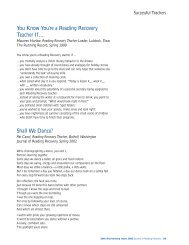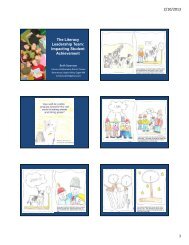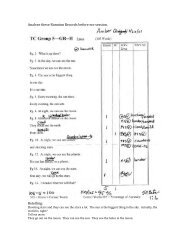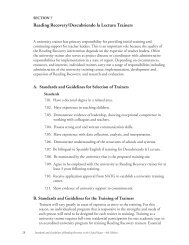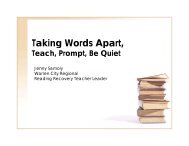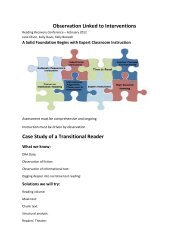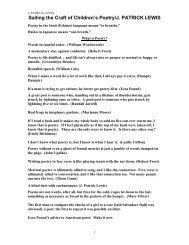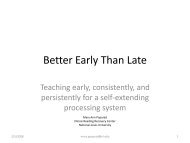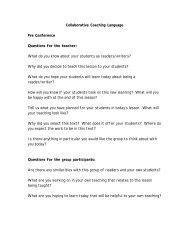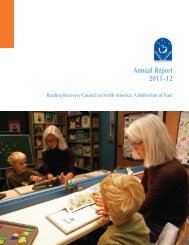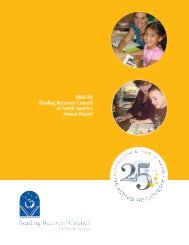Conversation As a Model of Instructional Interaction - Eric
Conversation As a Model of Instructional Interaction - Eric
Conversation As a Model of Instructional Interaction - Eric
You also want an ePaper? Increase the reach of your titles
YUMPU automatically turns print PDFs into web optimized ePapers that Google loves.
layout-8/l-2003 1/7/04 12:29 PM Page 36Literacy Teaching and LearningVolume 8, Number 1collaboratively constructing meaning” (p. 31). The child in Transcript 1 clearlyappears to take this more active stance to learning. He seems to see conversationas a means <strong>of</strong> sharing and clarifying ideas and views himself as a contributorto the conversation. In this model <strong>of</strong> learning, the teacher has to have amore informed theory <strong>of</strong> how human cognition develops within social contexts.This study creates the need for further research regarding the effects <strong>of</strong> aconversational model <strong>of</strong> instruction on student learning. Within the specificcontext <strong>of</strong> this study, additional research is needed to explore the affect <strong>of</strong> conversationon the co-construction <strong>of</strong> meaning needed for the successful reading<strong>of</strong> a new book. This will be done in a follow-up study to be completed in thenear future.This study also raises new questions. What can be considered genuine conversation?Is the type <strong>of</strong> conversation in instructional settings genuine conversationor is it some form <strong>of</strong> simulated conversation? Since the conversation thatoccurs within instructional settings has an instructional purpose or goal interms <strong>of</strong> what is to be learned by the student, does that make it less genuineand more simulated? Perhaps this type <strong>of</strong> conversation could be consideredguided conversation, where there are elements <strong>of</strong> informal everyday conversation,but there is also an element <strong>of</strong> guidance by the teacher who is attempting tolead the student to new understandings. This view would contribute to thehighly complex nature <strong>of</strong> the interaction and the discourse use within thiscontext.There are obvious limitations to this study due to the small number <strong>of</strong>teachers and students involved and the limited number <strong>of</strong> transcript samples. Itmay provide a starting point, though, for future studies with more teachers andstudents. Since this study focused on a small part <strong>of</strong> the Reading Recovery lesson,future studies could look at other aspects <strong>of</strong> the lesson in terms <strong>of</strong> conversationalinteraction. Classroom studies <strong>of</strong> conversational interaction would alsocontribute to further understandings regarding impact on student learning andthe need for quality pr<strong>of</strong>essional development for teachers.CONCLUSIONThe complexity <strong>of</strong> instructional conversation that allows for constructive knowerscreates a demand for expertly trained teachers. These types <strong>of</strong> conversationsare absolutely necessary for the development <strong>of</strong> thoughtful literacy, especiallyfor students at risk. Yet these conversations do not develop easily with studentswho have taken a passive stance to learning. Clay (1991) considers such childrenwhen she statesThe reading process will be learned haltingly, until he (the unresponsivechild) is confident enough to respond in the troublesome area.Coaxing that is not carping, support that is not demanding, confidence36



